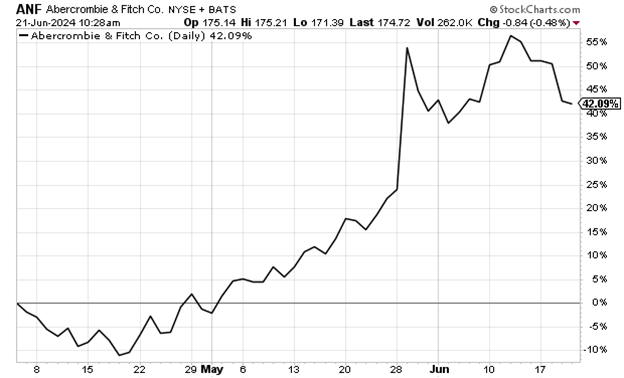
The U.S. consumer, the backbone of this economy, has been showing increasing strain over the last two years.
The latest figures from the Commerce Department released this week showed retails sales barely grew in May.
Here’s a summary from Bloomberg:
The value of retail purchases, unadjusted for inflation, increased 0.1% after an downwardly revised 0.2% drop in the prior month, Commerce Department data showed Tuesday. Excluding gasoline, sales rose 0.3%.
The figures underscore a notable downshift in consumer spending after stronger readings earlier in the year. Economists expect a moderate pace of spending going forward as Americans exercise greater prudence given persistent inflation, a gradually cooling job market and emerging signs of financial stress.
The economy is slowing… so we have to wonder…
Will the Federal Reserve decide it’s finally time to cut interest rates?
Previously, I shared Louis Navellier’s position that the Fed doesn’t know what it’s doing.
Is this new data point likely to tip the scales towards a cut? And how will the market react when they do?
The Fed’s Conundrum
First, let’s remember that the Federal Reserve has set interest rates at a target range of 5.25% to 5.50%. They decided at their June meeting about ten days ago to hold rates steady for the time being.
Here is Louis’ description of the situation that he shared with his Breakthrough Stocks subscribers yesterday:
The Federal Reserve is once again finding itself between a rock and a hard place.
There was only one major economic data report released in the holiday-shortened trading week, but it was a doozy. The Commerce Department revealed that retail sales rose only 0.1% in May, well below economists’ expectations for a 0.3% increase. April retail sales were also revised down to a 0.2% decline.
The fact is five of the 13 categories tracked by the Commerce Department contracted in May.
The one positive is that Wall Street continues to view “bad news as good news.” So, in the wake of the disappointing retail sales report, Treasury yields declined. The 10-year Treasury yield dipped to about 4.23% on Tuesday, down from 4.62% at the end of May and 4.47% on June 10.
(The 10-year Treasury yield currently sits at about 4.23% as I write Friday morning—Luis)
As you may know, the Fed does not like to fight market rates. So, as long as Treasury yields continue to fall, the Fed will feel the pressure to cut key interest rates sooner rather than later.
The current consensus expects the Fed to cut key interest rates in September, but I still believe our central bank needs to cut rates in July, too.
Louis believes that the market will explode higher once the Fed cuts rates, which we hope will be sooner rather than later. But, in the meantime, Louis doesn’t sit around waiting… he finds winners in any market.
A Retail Winner Despite the Gloom
By now, most of you know that Louis is a data guy.
It all started 40 some years ago when a group of open-minded professors offered Louis unprecedented access to Wells Fargo’s mainframe computers to build his very own stock selection models. This was before laptops, so this was a tremendous privilege.
After countless hours learning how to read and research market data, he built a stock selection model designed to mirror the S&P 500. But things didn’t turn out as planned.
Louis’ model did considerably better than the S&P 500! He engineered a formula that isolated a select group of stocks that consistently outperformed the S&P. These were smaller, supercharged companies that all had certain characteristics in common.
That model, Portfolio Grader, honed and perfected over time, is still churning out winners today – even in a weaking retail sector.
You’ve probably heard of Abercrombie & Fitch Co. (ANF), but you may not know that the company is more than 130 years old.
Originally, ANF was a retailer for high-quality camping, fishing and hunting gear, but it has greatly evolved since then.
Today, Abercrombie & Fitch is a global retailer that offers specialty apparel and accessories for men, women and children, both online and through its more than 750 stores around the world.
So, why is this retailer one of Louis’ Breakthrough Stocks picks? Here is his description from when he recommended the stock back in April.
The company noted that 2023 was a defining year for Abercrombie & Fitch, with full-year sales growing 16% year-over-year to $4.3 billion. Full-year earnings surged 2,412% year-over-year to $6.28 per share, compared to $0.25 per share in 2022. So, the company looks to build upon this success in 2024.
For fiscal year 2024, Abercrombie & Fitch expects total sales to grow 4% to 6% annually, with Abercrombie brands anticipated to continue to outperform Hollister brands in the Americas.
Given the positive outlook for this year, the analyst community has nearly tripled their earnings estimates for the first quarter over the past three months. First-quarter earnings are forecast to soar 292.3% year-over-year to $1.53 per share, which is up from analysts’ estimates for only $0.52 per share just three months ago.
Abercrombie & Fitch also has a history of posting big earnings surprises. In the four quarters of 2023, the company topped analysts’ estimates by 880%, 547.1%, 55.1% and 4.9%, respectively. So, the company is likely gearing up for another positive earnings surprise in May.
And sure enough, the company came through.
A double-digit winner in an increasingly weak retail sector drives home the value of Louis’ Breakthrough Stocks service that picks small and medium-cap stocks based on strong fundamentals and institutional buying momentum.
The Other Side of the Coin
One of the most valuable parts of Louis’ Portfolio Grader system is how it also tells him what stocks to avoid.
For example, Louis’ Portfolio Grader system rated Occidental Petroleum Corporation (OXY) as a sell before the stock fell 78% in 2022. Around that same time, it also said to avoid Marathon Oil Corporation (MRO) before it dropped 51% in three months… and Diamondback Energy, Inc. (FANG) before it crashed 79%.
And right now, the system is pointing to a massive and surprising new trend. Here is how Louis describes it:
The good news is another financial mania is coming that could open the kind of moneymaking opportunity I haven’t seen in two decades. The closest comparison to what’s coming next is what happened 25 years ago: The dot-com boom.
The bad news is it will likely be the last financial mania of my lifetime. And yours, too, if you’re over the age of 50.
Louis explains it all in a special event, Prediction 2024, next Tuesday, June 25, at 8 p.m. Eastern.
Reserve your spot for Louis’ free Prediction 2024 event by clicking this link.
Enjoy your weekend,
Luis Hernandez
Editor in Chief, InvestorPlace






